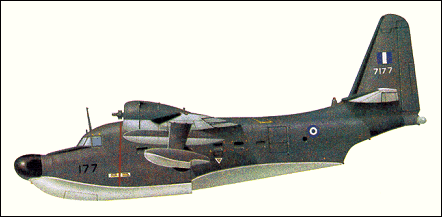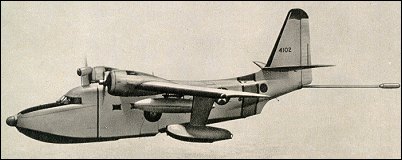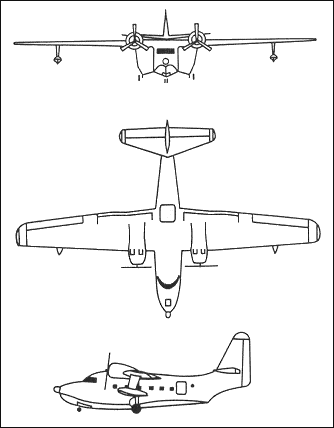|
| Experience with the Grumman Goose, which served throughout World War II with great reliability, prompted the US Navy to procure a somewhat larger amphibian with greater range capability. In 1944 the company initiated design of its Grumman G-64 aircraft, which was to be named Albatross, and which saw service with the US Air Force, US Coast Guard and US Navy. The prototype was flown first on 24 October 1947, and was of generally similar configuration to its predecessor. Fixed underwing floats were retained, but these and the entire structure had been considerably refined to reduce drag. Other changes included the provision of a cantilever, instead of strut-braced, tailplane; tricycle type retractable landing gear; and pylons beneath the wing, outboard of the engines, which could carry weapons, or drop-tanks to increase range. Additional fuel could also be carried in the underwing floats. Accommodation was provided for a crew of four and the cabin could accommodate 10 passengers, stretchers, or cargo, according to requirements.
The prototype ordered by the US Navy for service as a utility aircraft had the designation XJR2F-1, and flew for the first time on 24 October 1947. Initial production was of the UF-1 model, and a modified version introduced in 1955 was the UF-2. This latter aircraft had increased span, a cambered wing leading edge, ailerons and tail surfaces of increased area, and more effective de-icing boots for all aerofoil leading edges. In the tri-service rationalisation of designations in 1962, these aircraft became HU-16C and HU-16D respectively. Winterised aircraft for Antarctic service were designated UF-1L (later LU-16C), and five UF-1T dual-control trainers were rede-signated TU-16C.
The USAF found the G-64 attractive for rescue operations, the majority of the 305 ordered serving with the MATS Air Rescue Service under the designation SA-16A. An improved version, equivalent to the US Navy's UF-2, entered service in 1957 as the SA-16B; in 1962 these became HU-16A and HU-16B respectively. HU-16E was the designation (originally UF-1G) of Albatross aircraft operated by the US Coast Guard, and 10 supplied to Canada were designated CSR-110. An anti-submarine version with nose radome, retractable MAD gear, ECM radome and searchlight was introduced in 1961, and was equipped to carry a small number of depth charges. The versatile Albatross continues in service with a few air forces and navies, but its powerful and fuel-hungry engines have meant that surplus aircraft which became available for use were not a particularly attractive proposition to airline operators, and in consequence few were adapted for such a role.

| CREW | 2-4 |
| PASSENGERS | 10-22 |
| ENGINE | 2 x Wright R-1820-76A, 1050kW |
| WEIGHTS |
| Take-off weight | 14500-17000 kg | 31967 - 37479 lb |
| Empty weight | 10350 kg | 22818 lb |
| DIMENSIONS |
| Wingspan | 29.5 m | 97 ft 9 in |
| Length | 19.2 m | 63 ft 0 in |
| Height | 7.9 m | 26 ft 11 in |
| Wing area | 96.2 m2 | 1035.49 sq ft |
| PERFORMANCE |
| Max. speed | 379 km/h | 236 mph |
| Cruise speed | 360 km/h | 224 mph |
| Ceiling | 7600 m | 24950 ft |
| Range w/max.fuel | 5000 km | 3107 miles |
| ARMAMENT | bombs, missiles, torpedos |
| Hi guys, e-mail, 03.01.2009 13:36 I've lived most of my life in Greenland and worked many years in the aviation business. Also heard many stories, especially when USAF was stationed in Greenland. We heard about a SA-16 that have crashed in a lake in Sondre Stromfjord (Bluei West) in 1960 and have never been seen since. In 2005 we located it at greats depths and went for a dive. We found it and it's condition was good allthough it was split in two. If any of you guys have any information about the Albatross or have some friends who have been there, or some friends that know some friends I would appriciate if you would contact me. Kind Regards, Johan reply | | Willy Williamson (former AM1), e-mail, 16.12.2008 20:15 Hi Craig, been a long time. The one in E-City was second to last and I believe is 7243(please correct me if I'm wrong). I was a Flight Mechanic / aircrew on the "Goats" starting in 1976 and my last flight on 9 Mar 1983, the day before they retired the 7250(last one). Loved every second aloft even with 2 engines out... (not enough room here for that story) reply | | David D. Trotter, e-mail, 18.10.2008 22:45 I have two HU-16 Bush Pilot /Crewmember Goose Bay, Canada patches that I've had since 1977. I am trying to find out what unit wore them.I'm not sure that I can attach an image to this e-mail. If I can, I will, if not, I can do so later if requested. reply | | Udo Fischer, e-mail, 04.09.2008 18:15 1952 through 1967 I had been flying and parachuting first from SA-16 and then from HU-16 Air Rescue Service aircraft (then replaced in out unit with HC-97, the 'Cadillac of the Air'. The SA /Hu-16 was the 'cat's meow'! I always felt very safe in it, even during extreme conditions. reply | |
| | Albatross owner, e-mail, 29.08.2008 01:40 Info above generally accurate, with a few exceptions. No Air Forces or Navies still operate Albatrosses, the last were the Greeks, they had 14, parked their last in the mid '90's. The airplanes were never civilian certificated so can not be used "as is" for any kind of work for compensation or hire. 13 airplanes were converted by Resorts International back in the '80's to Standard Category ($3.5M each) and were used for a while by Chalks Airlines in FAR 121 airline operations. About 30+ airplanes flying /flyable and another 15-20 that could easily be made so. Rest are in museums, displays (including Jimmy Buffet's) and will likely never fly again. Contact me if you really want one. But this is not a cheap proposition. You REALLY have to want one and have $$$ to do this. BTW, the long wing version was all about single engine performance. SE service ceiling with the short wing was SEA LEVEL at 33K lbs. SE service ceiling with the long wing at same weight is 8000'. However, long wing airplanes have structural issues that short wings don't. reply | | Robbie Robbins, e-mail, 19.08.2008 05:42 I was assigned to the 58th Air Rescue Squadron (Unit changed to Air Rescue and Recovery Sqdn in 1966) Wheelus AB, Tripoli, Libya 2 /64 - 2 /67. Was a radio operator on HU-16B's. When I got there the HF /SSB radio on the airplanes was a Collins KWM-2A using a Johnson Matchbox for antenna loading. Had to stand up on the RO seat and face back to the top of the bulkhead across the isle to load the antenna every time we change frequency. The tuning dials on the Matchbox kept vibrating out of position, so it was a constant battle to stay on frequency. What a HOOT! We finally got the 618T to replace it. Most of us just stuck to the old AN /ARC-8 when we could get by without SSB. Many memorable missions that tour. Very trustworthy airplane in the hands of our great pilots. reply | | Craig McCrodden, e-mail, 12.08.2008 15:41 I was stationed at Otis ANG Base on Cape Cod from 80 - 82 and I was one of the last military aircrews to fly the HU-16's. Great plane but you could not hear a thing on takeoff roll and they leaked like sivs... Shortly after I left for my next assignment the last of the breed left for Elizabeth City and now it sits at the front gate on a pedistal... reply | | Doyle F. Howe, e-mail, 31.05.2008 03:29 While assigned to the Air Department at Kodiak Naval Station (Alaska) 1952-1953 I was crew chief on SN 22893. See the monkeyview website link below for some interesting pictures of the UF-1 and other Alaska sights.
www.monkeyview.net /id /4191 /yesteryear /index.vhtml reply | | John Gould, e-mail, 09.05.2008 07:03 I flew as radio operator 1955-56 at Goose bay, Labrador in the 54th ARS. We had 5 of these great aircraft. Flew to Greenland and allot of other places in the area. We picted up a SA-16 at the Grummand plant in "56. Would enjoy talking to anyone that served with this aircraft and any others in that country, John in Payson, AZ johnnygo@localnet.com reply | | steven weaver, e-mail, 09.05.2008 03:25 The SA-16 was one of my favorit4e airplanes, My dad was a career Air Force Pilot and he flew air rescue out of Elmendorf from 1953-1956. His name was Captain Truman "Pappy" Weaver. He loved flying that plane and in those conditions. It was a wonderdful place to spent some childhood years. I still have a pre-made model of that plane my dad gave me for my 7th birthday. I would love to hear form anyone who knew my dad. dwtrain@yahoo.com steven weaver reply | | Robert, e-mail, 18.03.2008 22:59 Hi! I'm looking to purchasing of these planes for business use. We would need to land on water and snow..can anyone suggest? Thank you for your help! Best regards, Robert reply | | allan pochop, e-mail, 15.01.2008 18:30 Flew SAR on BuNo 137922, (was a UF-1 converted to a UF-2) NAS Port Lyautey,Kentria, Morocco 1960-62. Best two years of duty out of the eight active years.
Did the JATO thing out of the bay of Gibraltor.
137922, did time at Midway, Is. South America, and ended up in the Philapene (sp) air force, cut up for scrap in 1995. Shame /. reply | | Frank Tuzzio, e-mail, 17.12.2007 06:57 I was assigned to the 71st Air Rescue Squardon at Elmendorf AFB in Anchorage Alaska 1952 to 1953. We had 6 SA 16's. I was a propeller mechanic. The propeller was the Hamilton 43D50 Electric. I have many fond memories of this aircraft, and the many times I removed, repaired and installed the propellers on this aircraft. Also of the many times I flew in one in beautiful Alaska, especially the water landings and JATO take offs from water. I enjoyed reading this page. Thank you. reply | | Keith Sage, e-mail, 19.05.2007 07:27 As soon as I get my $#!^ Together I plan to buy one..
This would be great as a bush plane well for me and my friends. I realy wont one. reply |
|
Do you have any comments?
|
| 
COMPANY
PROFILE
All the World's Rotorcraft
|








